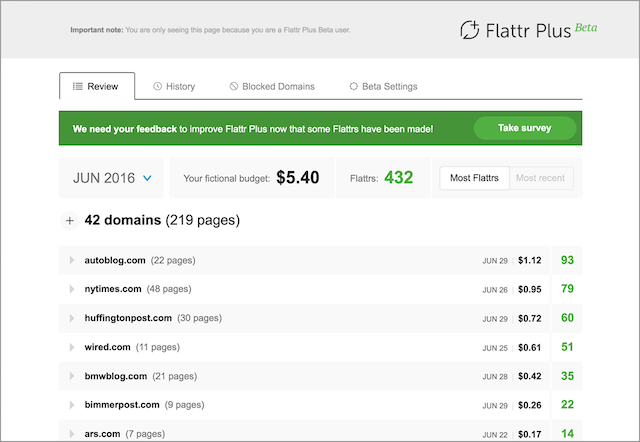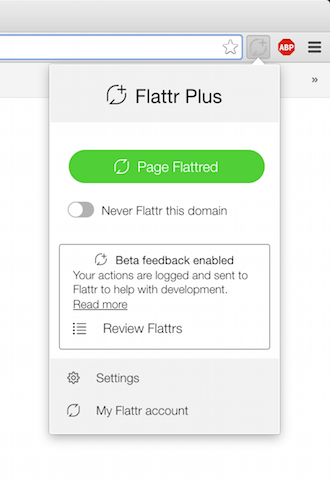Adblock Plus and (a little) more
BIG Flattr Plus update · 2016-07-07 17:05 by Ben Williams
Since we announced Flattr Plus in early May we’ve been working hard to perfect what we believe is the web’s missing (monetization) link. It’s been encouraging, and exciting, developing an easy, automatic solution to fund content.
We’re still on track with the closed beta, which will be ready in the early fall (sign up here), and the open beta, too, which will launch late fall or early winter.
For now, we wanted to inform you about the exciting developments on Flattr Plus that have happened since May. Specifically, we wanted to show you how the design is progressing, give you a peek into the data intelligence and development going into the extension and tell you about the new API on Flattr.com.
So we’ve done a lot of conceptualization and engineering to make Flattr Plus run like a well-oiled machine on the inside.
But what about on the outside? How does it feel from your perspective as a user? Sure, Flattr Plus will allow you to easily and automatically fund your favorite content, but is it free-flowing and intuitive?
The short answer is yes. Below is an interface we created for testing and collecting feedback. Bear in mind, this is just a testing screen we’re using to sharpen the algorithm.
One of the biggest challenges the Flattr Plus project faces is determining what signifies a flattr? What browsing activity, in other words, should trigger a monetary transfer to a particular site? And how do you keep that private?
It’s sort of the crux of everything: making flattrs automatic is what makes Flattr Plus unique: no one’s ever made a payment system quite like Flattr Plus – even Flattr. One of the first things we did to shine light into this unknown territory was to just gather browsing behavior from our friends, colleagues and family, who volunteered to share all their browsing data. The idea was that by taking the maximum amount of data possible, you find the minimum amount required for the extension to work. The process is a bit like whittling a stick: you start with a large, unwieldy piece, then carve it down to something small and intricate.
After analyzing all their browsing habits, we developed several ideas for algorithms that would trigger a flattr. Next we implemented a dashboard to show the output various algorithms produced. Here is another test screen, this time for the bubble UI:
And of course we did some good, old-fashioned interviews of our friends/guinea pigs.
However, before we could extend the test to beta testers, we needed as privacy-friendly a way as possible to get useful data. This was made possible by the stick-whittling process I refer to above, but beta testers will have to volunteer some information if they want to test (of course we absolutely tell them this in a big, fat disclaimer). And rest assured: the final version available to the general public will be 100 percent privacy-friendly. This is a requirement for us, not a mere priority.
For now though … still whittling that stick, not to mention polishing up the code and freeing it of issues.
Finally, deciding what triggers a flattr is relevant to how the extension will function – but what happens when the extension sends data to Flattr.com, so that it can disburse money to worthy content creators?
Well, the rollout of Flattr Plus demands a fairly significant number of changes to the existing Flattr system. The most substantial part of this is a rebuilt API and a new approach to how flattrs are handled. Chief among those new approaches is getting rid of “things.” Previously, as existing Flattr users knows, Flattr worked by allowing a number of elements – “things” – to serve as identifiers for what was able to be flattred. For Flattr Plus the sole identifier for what is flattrable will be the URL, i.e., the extension will send the URL to the Flattr API using a secure connection, and the Flattr API will determine the owner of the URL without knowing the behavior that led to the flattr; so obviously, we had to do away with “things” as identifiers. Read more about this on the Flattr Blog.
We are now also starting to create the all-important onboarding for new users. Getting the add-on in the browser, creating an account, the payments flow and the dashboard all have to work perfectly together with Flattr Plus. In addition, we added a small FAQ on our blog. The next step is to start work on how Flattr Plus will be integrated into Flattr.com.
Finally, we’ve been speaking to publishers worldwide about opening their sites to receive funds from Flattr Plus users. Thus far those conversations have been very fruitful, and we’re pleased to report that publishers have shown a great deal of enthusiasm to employ Flattr Plus when it rolls out.
For now, please help us make the one thing the web has always wanted come true: you can start testing the beta this fall.

Comment [1]
Commenting is closed for this article.


Leather Bags Manufacturers · 2016-07-10 12:52 · #
Thanks Ben for the Flattr Plus Update.
Reply from Ben Williams:
You bet! We’ll be following up on these with a little more regularity, at least when we’ve got enough to talk about, in the next few months.